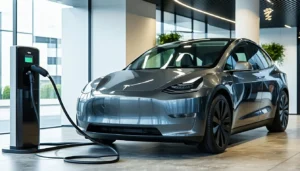After a challenging few years, the auto-leasing market is once again poised for growth. The car leasing market is projected to expand at a CAGR of 7.8% to reach $123.87bn by 2028. The winners in this new market will be those who can add capacity and new business without damaging their customer experience.
In the modern leasing market, a positive customer experience is no longer a ‘nice to have’ – it’s the foundation of a successful business. Brands with superior customer experience bring in 5.7 times more revenue than competitors that lag in customer experience. That’s because delivering a leading experience is key to generating reliable revenue and minimising costs.
By building processes that simplify life for your customers, you can move to a more profitable, scalable service model that drives ROI throughout your business. In this guide, we examine the key challenges facing leasing businesses and explore the opportunities to improve return on investment through superior customer experience.
Why the leasing experience needs to evolve
The automotive leasing market has always been closely tied with technology, demographic and commercial trends, adapting to the needs of businesses and employees. Today, in a time of rapid evolution in working habits and mobility, leasing is poised for another evolution.
The auto-leasing opportunity
Regulatory and demographic trends are creating a fertile environment for growth. Much of this stems from government efforts to incentivise electric vehicles through tax benefits and salary schemes – EVs recently made up 31% of business contract hire orders and 68% of salary sacrifice orders.
Meanwhile, employees moving further from the office creates a need for more flexible vehicle use. Leasing and mobility providers are a natural partner for businesses looking to improve their mobility programmes, creating an opportunity to grow revenues and expand into new verticals.
While this will increase competition in an already tight market, businesses that can offer a compelling customer experience have a chance to create competitive advantage and win significant market share.
Challenges in the leasing experience
Due to a combination of legacy systems, manual processes and complex business models, many businesses are not set up to provide the experience customers expect. Not only does this harm win-rates, retention and growth, but inefficient processes also reduce sales margins.

By investing in systems that enable a consistent, efficient and valuable customer journey, leasing companies can improve performance across the customer lifecycle.
What are the key challenges in leasing?
Leasing is a complex process, with a wide range of internal and external stakeholders, data points and workflows to consider, creating significant operational challenges for providers. But those that can solve these issues can create a standout service that drives growth and retention.
1. Data management and visibility
Leasing, and especially mobility, is a data-heavy industry and getting more so. The way your business stores, structures and analyses its data is a key determiner of performance and the service you can provide. Data sources to consider include:
Customer data
- Order history
- Driver data
- Contract performance
- Open banking data
- Open accounting data
Procurement data
- Manufacturer terms
- Changing catalogue information
Fleet data
- Telematics insights
- Vehicle history and conditions
- Service data
- RFL/MOT data
Without an efficient way to manage this information in real time, businesses are left in the dark regarding customers and their needs, leading to missed opportunities and poor service. However, many legacy systems are not set up to efficiently structure and update this data, leaving providers at a disadvantage.
The Discount Dilemma
For many providers, managing discounts is a cost-centre. Regularly updating terms for your organisation and your customers across a range of manufacturers multiple times a year is time consuming and inefficient. Without a centralised means of storing and comparing discount data, it’s impossible to use the data effectively. However, by moving to a digital discount management platform, leasing and mobility providers can use this data to:
- Negotiate better deals with manufacturers based on historical data
- Give their salesforce a competitive advantage through faster response times
- Offer clients more competitive pricing and valuable insights
2. Manual processes
The multi-stage sales and customer management journey for
leasing is time consuming and labour intensive for teams and
customers. With multiple stakeholders involved, it’s easy for
steps to be missed, information mislaid and errors to appear.
To close a deal, teams have to deal with:
- Manual quoting
- Ratebook creation
- Manufacturer engagement and procurement
- Proposal creation
- Proposal interaction and closing
Managing these processes across teams using email, spreadsheets and phone calls significantly slows down customer service and increases internal friction between sales and operational teams. Delays increase the likelihood of losing a customer to a more nimble competitor and reduce scalability, limiting long term growth.
3. Lack of flexibility
Customer needs are changing, as fast as the market itself with businesses looking to:
- EV use
- Value-add services
- Shared vehicle usage
- Mobility as a service (MaaS)
While these trends are creating new opportunities in the market, they also bring their own challenges. Legacy systems make it hard to adapt processes and add new services. Modern leasing customers want deals focused on them and their unique position, requiring providers to be able to quickly take in all their data and turn it into a tailored proposition.
However, manual processes such as term sheet entry prevent lessors from being able to efficiently tailor offers to customer needs, leading to generic pricing, increasing churn risks for customers leaving room for more agile competitors who can more accurately meet their needs.
Creating a winning customer experience
1. The connected data journey
Customer experience starts with reliable visibility. Without the ability to track activity inside and outside your team, teams are unable to effectively prioritise tasks, tailor activity to customer needs and coordinate the sales process.
This starts with implementing a single view of all relevant data that takes customers from first engagement through their lifecycle with you.
Centralise data at customer onboarding
- From first engagement, add all customer information to a single customer relationship management system (CRM)
- Digitise terms data to compare with market rates and competitors
- Use gathered information to create a digital proposal that meets the customer’s needs
Engage consistently throughout the deal
- Use internal automated updates on deal stages to keep the process on track
- Share quotes digitally to enable shared real time visibility for customers
- Work with customers online for quote tailoring to reduce manual back and forth
Close decisively
- Build contract terms into your system functionality, setting parameters such as maximum mileage based on customer needs, to ensure clarity for all parties
- Set benchmarks for sales windows and communication levels for your team to guarantee service quality
A fully trackable digital system improves consistency, reduces human error, time spent on data review and helps spot upsell and retention opportunities.
2. Automating manual tasks
Once customer data is in your system, automation can help move, manage and analyse your information. This frees up your team’s time to focus on understanding your customers’ needs rather than processing data.
Manual tasks that can be productively automated include:
- Uploading legacy customer data on first engagement
- Automating email communications with customers to remind them of outstanding actions and deliverables at key milestones in the sales process
- Managing customer discounts through a dedicated system that speeds up the quoting process
- Integrating your quoting system with a wider range of suppliers to offer more competitive options
- Giving customers the ability to feed back directly on digital quotes
- Integrating specialised tools to handle key parts of the financing process, such as connecting your sales and inventory systems to track how many vehicles have been sold and ordered to create a real-time view of available stock
Smart automation improves your speed of service, data accuracy, and response time, while enabling your team to close more deals and focus on customer satisfaction.
3. Driving value through your systems
Your team can then focus on making a difference for customers through tailored, data-driven engagement.
Data-driven value
- Using a digital ratebook to prove value compared to other suppliers
- Reviewing historical data and customer comparisons to maximise customer deal satisfaction
- Helping customers to reduce costs with tools like mileage trackers to enable rebates
- Providing analysis to customers on the value you deliver to build trust and strengthen relationships
Analysing customer experience
- Regular NPS scoring to track customer satisfaction
- Automating content journeys with customers to deliver value beyond the initial sale
- Re-engaging at key benchmarks to ensure that customers are happy with your service
By building closer relationships with customers, you can maximise long-term retention, customer satisfaction, strengthen your competitive positioning and brand reputation and secure more recommendations.
Accelerate: The customer-first leasing and lending platform
Automotive leasing is overdue a customer experience revolution and this starts with the right technology. Accelerate by QV Systems is a cloud-native platform that gives you the tools to build value-driven, long-term relationships with your customers.
From enquiry to delivery, you can optimise every stage of your sales journey to deliver better results for your customers and your business.
Manage customers with end-to-end visibility
- Integrated CRM: Track and tailor deals from enquiry to delivery
- Discount data and terms integration: The only solution to place the appropriate value on this critical data
- Simplified customer management: Automate lifecycle management based on your own service models
Smart automation
- Digital proposals, quotes and procurement: Close deals faster with full connectivity and digital tools.
- Automated milestones and reminders: Never miss an opportunity with in-built reminders
- Holistic risk management: Get the insight you need with soft search and user-configurable scorecard functionality
Flexible technology
- Open API integration: Use the latest value-adding tools to evolve your service
- Regular updates: Stay on the cutting edge with new technology and integrations
- Flexible connections: Onboard a range of customer tech stacks to widen your target market
To find out how Accelerate can put your business in the strongest position for the future, get in touch with one of our advisors today.


